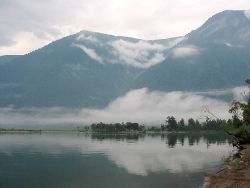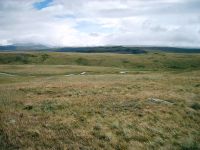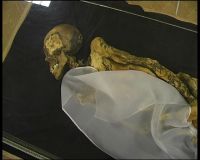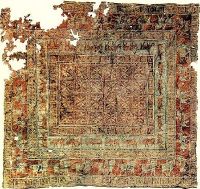Golden Mountains of Altai
| Golden Mountains of Altai* | |
|---|---|
| UNESCO World Heritage Site | |
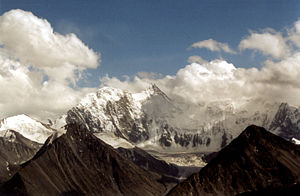
| |
| State Party | |
| Type | Natural |
| Criteria | x |
| Reference | 768 |
| Region** | Europe |
| Inscription history | |
| Inscription | 1998 (22nd Session) |
| * Name as inscribed on World Heritage List. ** Region as classified by UNESCO. | |
Golden Mountains of Altai is the name of an UNESCO World Heritage Site consisting of the Altai and Katun Natural Reserves, Lake Teletskoye, Belukha Mountain, and the Ukok Plateau. As stated in the UNESCO description of the site, "the region represents the most complete sequence of altitudinal vegetation zones in central Siberia, from steppe, forest-steppe, mixed forest, subalpine vegetation to alpine vegetation".[1] While making its decision, UNESCO also cited Russian Altai's importance for preservation of the globally endangered mammals, such as snow leopard and the Altai argali. The site covers a vast area of 16,175 km².[2]
Notes
- ↑ Golden Mountains of Altai. UNESCO. Retrieved 2007-07-31.
- ↑ Greater Altai – Altai Krai, Republic of Altai, Tyva (Tuva), and Novosibirsk - Crossroads. Retrieved 2006-11-30.
External links
- Location map
- Altai Republic Recreation Areas
- Golden Mountains, Altai Republic, Russia
- Golden Mountains of Altai at Natural Heritage Protection Fund
| Lake Teletskoye Altyn-Köl | |
|---|---|
| Location | Altai Republic |
| Coordinates | |
| Primary sources | Chulyshman River (70 rivers and 150 temporary streams) |
| Primary outflows | Biya River |
| Basin countries | Russia |
| Max length | 78 km (48 mi) |
| Max width | 5 km (3 mi) |
| Surface area | 233 km² (90 sq mi) |
| Max depth | 325 m (1,066 ft) |
| Water volume | 40 km3 (9.6 cu mi) |
| Surface elevation | 434 m (1,424 ft) |
Lake Teletskoye (Russian: Озеро Телецкое, Altay: Алтын Кӧл, Altyn-Köl, literally: "Golden Lake") is the largest lake in the Altay Mountains and the Altai Republic, Russia. It is one of 25 deepest lakes in the world, having a depth of up to 325 meters.[1]
Situated at a height of 434 m (1,424 feet) above sea level, the lake is 78 km (48 miles) long and 5 km (3 mi) wide and lies between the mountain ridges Korbu and Al-tyntu, on the junction of Sailughem Mountains and Western Sayans. Its surface area is 233 km² (90 sq mi); however, due to its considerable depth (325 m, 1,066 ft), the lake contains no less than 40 km³ (15 sq mi) of fresh water. Annual water level fluctuations are estimated at some 348 sm. The lake transparency is high, with the visibility of the lake water ranging from six to fourteen meters.
About 70 rivers and 150 temporary streams flow into the lake, the largest of them, Chulyshman River, supplying more than half of the lake's water. The lake is drained through a single outlet, the Biya River, which, after its confluence with the Katun River, forms one of Siberia's largest rivers, the Ob River.
The lake is surrounded by mountains of 600-1,300 m in the northern part and about 1,700-2,400 m (5,600 - 7,900 ft) in the southern part. Lake Teletskoe is included into Altaisky Nature Reserve. That reserve along with the Katun Natural Reserve and the Ukok Plateau Nature Refuge were listed as one of UNESCO World Natural Heritage Sites under the name "Golden Mountains of Altai".[2]
Notes
- ↑ Altai Reserve. altai-republic.ru. Retrieved 2007-07-31.
- ↑ Altai - Pearl of Siberia. Retrieved 2006-11-30.
| Belukha Mountain | |||
|---|---|---|---|
 Belukha, summer 2001 | |||
| Elevation | 4,506 metres (14,783 ft) | ||
| Location | Russia | ||
| Mountain range | Altay Mountains | ||
| Prominence | 3,343 m (10,968 ft) | ||
| Geographic coordinates | {{#invoke:Coordinates|coord}}{{#coordinates:49|48|25.5|N|86|36|23.3|E|type:mountain | name=
}} | |
| First ascent | 1914 by B.V. Tronov & M.V. Tronov | ||
| Easiest Climbing route | basic rock/snow climb | ||
Belukha Mountain (Russian: Белуха; Altai: Muztau), located in the Katun Mountains, is the highest peak of the Altay Mountains in Russia.[1] It is part of the World Heritage Site entitled Golden Mountains of Altai.[2]
Belukha is a twin-peaked mountain massif that rises along the border of Russia and Kazakhstan, just north of the point where these two borders meet those of China and Mongolia. There are several small glaciers on the mountain. Of the two peaks, the eastern peak (4,506 m, 14,784 ft.) is higher than the western peak (4,440 m, 14,567 ft.).
Belukha was first climbed in 1914 by the Tronov brothers. Most ascents of the eastern peak follow the same southern route as that taken in the first ascent. Though the Altai is lower in elevation than other Asian mountain groups, it is very remote, and much time and planning are required for its approach.
Notes
- ↑ Mount Belukha. Encyclopedia Britannica. Retrieved 2007-07-31.
- ↑ Golden Mountains of Altai. UNESCO. Retrieved 2007-07-31.
External links
Ukok Plateau is a remote and pristine grasslands area located in the heart of southwestern Siberia, the Altai Mountains region of Russia near the borders with China, Kazakhstan and Mongolia. The Pazyryk is the name of an ancient people who lived in the Altai Mountains on this plateau who are associated with some spectacular archeological findings, including mummies found frozen in the permafrost. Many ancient Bronze Age tomb mounds have been found in the area and have been associated with the Pazyryk culture which closely resembled that of the legendary Scythian people to the west.[1] The term kurgan is in general usage to describe such log-barrow burials. Excavations of this site have continued to yield fascinating archaeological findings.[2] One famous finding is known as the "Ice Princess" excavated by Russian archaeologist, Natalia Polosmak.[3][4] Three tattooed mummies (c. 300 B.C.E.) were extracted from the permafrost of the Ukok Plateau in the second half of the 20th century.[5]
It is recognized as part of the UNESCO World Heritage Site entitled Golden Mountains of Altai as an important environmental treasure. It provides a habitat for many of the world's endangered species including one of its least studied predatory animals: the snow leopard. Other endangered species protected there include the Argali mountain sheep, the steppe eagle, and the Black Stork.[6] Currently the Ukok Plateau is being threatened by plans for a gas pipeline between China and Russia. It is also being threatened by a proposal to build a road through it as well as overuse of the steppe by ranchers.[7]
The Ice Maiden and other archaeological finds were located just within a disputed strip of land between Russia and China.[8] The residents of the Altai Republic are demanding the return of the burial artifacts from their current location in Novosibirsk.[9]
Notes
- ↑ Bahn, Paul G. (2000). The Atlas of World Geology. New York: Checkmark Books, p 128. ISBN 0-8160-4051-6.
- ↑ Golden Mountains of Altai. UNESCO. Retrieved 2007-07-31.
- ↑ Ice Mummies: Siberian Ice Maiden. PBS - NOVA. Retrieved 2007-07-31.
- ↑ Prehistoric Art - Early Nomads of the Altaic Region. The Hermitage Museum. Retrieved 2007-07-31.
- ↑ Bronze collect at Novosibirsk State University - including Pazyryk. Retrieved 2006-11-30.
- ↑ Protect Snow Leopard Habitat / Siberia. forests.org. Retrieved 2007-07-31.
- ↑ Altai: Saving the Pearl of Siberia. Retrieved 2006-11-30.
- ↑ Leigh Fenly (December 8 2004). Archaeology News. Retrieved 2007-11-27.
- ↑ Minor nationality of Russia demands the return of "Princess of Ukok". Pravda (February 21 2005). Retrieved 2007-11-27.
ReferencesISBN links support NWE through referral fees
- S.I. Rudenko, Kul'tura naseleniia Gornogo Altaia v skifskoe vremia ("The Population of the High Altai in Scythian Times")(Moscow and Leningrad, 1953) translated as Frozen Tombs of Siberia: The Pazyryk Burials of Iron Age Horsemen, M.W. Thompson, tr. (University of California Press, Berkeley) 1970. ISBN 0-520-01395-6
External links
- Greater Altai – Altai Krai, Republic of Altai, Tyva (Tuva), and Novosibirsk
- Gas pipeline route in south Siberia to be approved in August
- A collection at Novosibirsk State University site, including Pazyryk
| |||||||
Credits
New World Encyclopedia writers and editors rewrote and completed the Wikipedia article in accordance with New World Encyclopedia standards. This article abides by terms of the Creative Commons CC-by-sa 3.0 License (CC-by-sa), which may be used and disseminated with proper attribution. Credit is due under the terms of this license that can reference both the New World Encyclopedia contributors and the selfless volunteer contributors of the Wikimedia Foundation. To cite this article click here for a list of acceptable citing formats.The history of earlier contributions by wikipedians is accessible to researchers here:
- Golden_Mountains_of_Altai history
- Lake_Teletskoye history
- Belukha_Mountain history
- Ukok_Plateau history
The history of this article since it was imported to New World Encyclopedia:
Note: Some restrictions may apply to use of individual images which are separately licensed.


